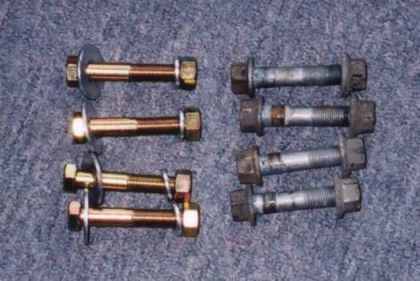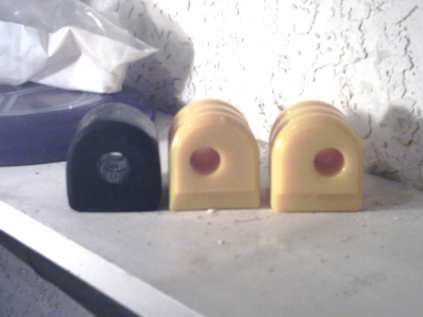[ Start ] [ Wheels & Tires ] [Bushings ] [ Springs & Struts ] [ Sway Bars ] [ Alignment ] [ Drivetrain ] [ Miscellaneous ] [ Racing ]
A proper alignment is critical to good performance in handling. It makes sense that the wheels all need to be pointing in the same direction, but some specific angles can be changed to “alter” the vehicle’s handling characteristics.
Sadly, alignment angles that work well for a performance application are often not conducive to pedestrian street manners or tire longevity. I endeavoured to make the best compromise in setting up the vehicle. I wanted the best of both worlds. In the end, a highly competitive compromise was unattainable.
| Alignment Angles Camber Toe Caster |
Camber
Camber is the vertical angle of the tire as viewed from the front. If the tires tip in towards the centre of the car it is negative camber. If they tip out, positive.
Negative camber is desirable in autocross racing as it provides a more vertical tire once the vehicle is mid-turn, and the body has leaned and the suspension has “set.” An easy way to achieve more negative camber is to elongate the top strut-to-hub mount holes in the strut towards the strut. This allows the front hub to be tipped in at the top when assembled, thus producing more negative camber. For every millimeter the strut holes are elongated, 1/2° negative camber is gained. This modification is illegal for CACC Super Stock rules.
As the car sat, I had approximately -1.2° camber up front. Not enough. My solution was to use “crash bolts.” I replaced the OEM 12mm strut bolts with two (per side) 7/16×2.5″ Grade 8 UNF zinc/cadmium plated bolts which resulted in -2.2° camber. Be sure to torque these fasteners to 85 ft-lbs as per manufacturer’s specifications. After some time with a skid pad and a tire pyrometer, it was found that this was still not enough. I then went to two 10mm 8.8 fasteners for a total of -3.2° camber. This worked fantastically. Unfortunately, these fasteners can only by torqued to 55 ft-lbs, and they will slip easily. Coating the strut flange with Loctite®, paint or similar adhesive can reduce the slipping, but re-torque the fasteners any time you have the wheels off. You can also “tweak” the lower control arm mount to move the control arms outward for more negative camber.
Running this kind of camber can rapidly destroy street tires. Some folks argue that it isn’t camber that kills tires, it’s toe. I think these people don’t drive enough. Camber kills tires – don’t let anyone tell you otherwise. Toe is worse, much worse, but camber does kill tires. I had run -2.2° camber up front for one year in an effort to compromise between street and track, and set the toe to 0° to maximize tire life. It didn’t work. The fronts had to be swapped on the rim outside for in to get some life out of the tires. P175/70R13 Walmart tires might have been more forgiving, but 50 series Kumho Ecsta 712’s were not enjoying the camber.
On an interesting note, Toyo recommends “-2.5° to -5.0°” camber for their Proxes RA-1 tires.
Toe
Toe is how parallel the tires are to each other, as viewed from the top. If the tires are pointing away from each other at the front, it is toe-out, or positive. Pointing towards each other is toe-in, or negative.
Toe is used to encourage the vehicle to “turn-in” (that is, to respond to steering input). For competition, most vehicles are set up with a small amount of toe-out (that is, that the front of the tires are pointing away from each other). This adds to the amount of Ackerman (or “toe-out-on-turns”), and increases responsiveness. I have been reading up on Ackerman, and although it cannot be easily changed in a production car, it is an interesting topic worthy of further study.
While toe-out makes the car a whole lot of fun, in everyday driving the tire is actually being dragged sideways slightly for every distance traveled. This can cause considerable tire wear.
In order to maximize tire life (due to the increased negative camber from lowering the car), I set the toe to 0° instead of the factory recommended setting of 0.60° total toe out. The car is still fairly responsive on the street, especially with the rear toe being set to 0°. Rear toe contributes to the responsiveness of the back of the car. Generally, lightweight cars are set to 0° or slight toe-in to keep the back more stable. In heavier cars a bit of rear toe-out can induce a bit more oversteer to help the car rotate. The Sentra is only 2500 lbs, and setting the rear toe to 0° helps step the rear out a bit.
There is a theory that toe-out is given to front-wheel-drive cars since the drive action on the front wheels causes the wheels to toe-in due to the engineered scrub radius of the front suspension. I may experiment with a bit more front toe-out and see how it affects tire wear. My tires do not currently exhibit wear due to toe-in.
After changing the Springs, I neglected to re-align the rear toe. At the 2003 Canadian Nationals I was not entirely happy with the car’s rotation. After the event I checked the toe – 1/8″ toe in! Nasty! For the BC Championships, I adjusted it to what I thought was 0, but turned out to be 1/4″ toe out (It was night, I had a flashlight, yadda yadda yadda). Holy oversteer! What a wild ride! Quite unsettling on the ride home, too.
After eight months, the inside 1″ of tread was basically obliterated from toe wear…
Caster
Caster is the angle between an imaginary line drawn through the centre of the steering axis and the vertical centreline of the wheel, as viewed from the side. If the top of the steering axis is behind the wheel axis, it is positive. If it is in front, it is negative and the car would become horribly unstable at any speed.
Caster affects stability at speed. More caster increases stability, but at the cost of steering effort. Power steering equipped cars often have more caster than manual steering cars.
Caster also, by it’s very nature, increases camber as the wheels are turned left or right. This can work to our advantage as it gives us the camber we want, when we want it. Given enough caster, we can run less static camber which can improve acceleration and braking as the tire is in more effective contact on the ground.
Ironically, there is virtually no one trying to change the caster on a B13 Sentra in North America. Whiteline out of Australia has developed a considerable amount of products the B13 NX and the N14 Pulsar, which also uses the B13 suspension. Whiteline offers offset bushings for the N14 (Part number KCA303) that will provide approximately 3.5° caster! I installed these in the winter of 2004, and they are documented in the Bushings Page. These bushings are not legal in Super Stock.
On an interesting note, Toyo recommends “as much as possible” caster for their Proxes RA-1 tires.
Settings
For a street/autocross compromise, I initially set the car’s alignment to the following (keeping in mind, only Toe is officially adjustable):
| Alignment Settings | |||
| Angles | Specification (per wheel) | Setting | |
| FRONT | Caster | +0.67° to +2.17° | 2.30° |
| Camber | -1.33° to +0.17° | -1.20° | |
| Toe | 0.00° to +0.30° | 0.00° | |
| REAR | Camber | -1.75° to -0.25° | -1.20° |
| Toe | -0.23° to -0.37° | 0.00° | |
One way to fine tune your alignment setup is to analyze tire temperatures. This involves driving around a skid pad (a 100 foot diameter circle) as quickly as possible to build up some heat in the tires, then stop and take the temperatures across the tread with a tire pyrometer. Ideally you want to see temperatures fairly even across the tread.
| Temperature | OUTSIDE | CENTRE | INSIDE |
| HIGH | Insufficient Negative Camber | Excessive Pressure | Excessive Negative Camber |
| GOOD | E v e n – T e m p e r a t u r e s | ||
| LOW | Excessive Negative Camber | Insufficient Pressure | Insufficient Negative Camber |
In running -2.3° camber as previously mentioned, this is what I found:
| Tire Temperatures | |
| Left Front: 158-145-101 °F | Right Front: 119-147-163 °F |
| Left Rear: 123-120-93 °F | Right Rear: 87-111-119 °F |
| Test Parameters Test conducted at Boundary Bay Airport Temperature: 30°C Wheels: 13×7″ rims, Tires: Toyo Proxes RA-1 205/60R13 Pressure: 44psi front, 38psi rear Alignment: toe=0°f/r, camber=-2.2°/-1.2°f/r |
|
Since the outside edges are consistently higher than the inside edges, the outer edges are overworking. I need more negative camber. I could run -3.2° negative camber maximum, but doing so is going to destroy my street tires, so I decided to setup the camber for street (-1.2° front and rear), and then adjust the camber and toe at the track. By using “crash bolts,” setting the camber is easy, and knowing how many turns to put into the tie rod ends makes adjusting the toe almost as easy. So now I change the alignment settings once I got to an event, then changing them back when I leave. I’ve gotten it down to 45 minutes to do the changes while swapping the street tires to race tires.
Notice, also, that the front centres are higher than they should be, considering the inside and outside temperatures. This is evidence that the front tire pressures are too high – a necessary evil to keep the wear off the sidewalls with insufficient negative camber.
This truly became a pain in the butt after just half a season, but this is the compromise I must make to run a dual-purpose car.
Running higher spring rates would also reduce the required amount of static camber.
On an interesting note, Toyo recommends “160-220°F” running temperatures for their Proxes RA-1 tires. They also recommend 41-43psi hot pressure, starting no less than 24psi for a FWD.
I would recommend camber goals to be:
| Recommended Camber | ||
| Usage | Front | Rear |
| Race | -3° | -2° |
| Street and Track | -2° | -1° |
| Street | -1° | -1° |



